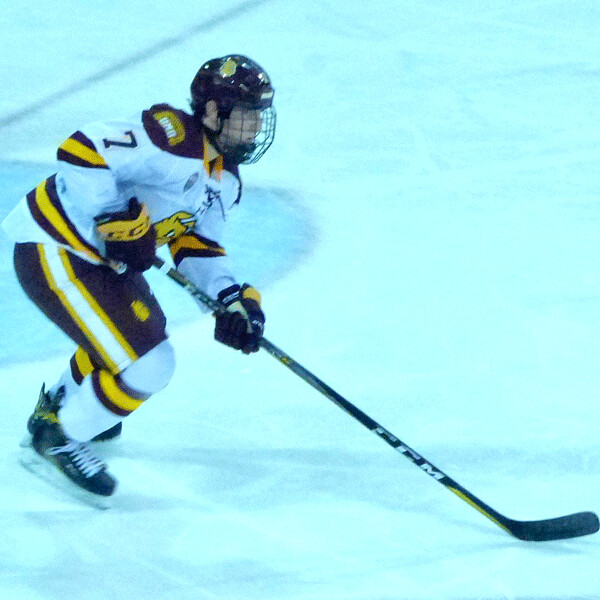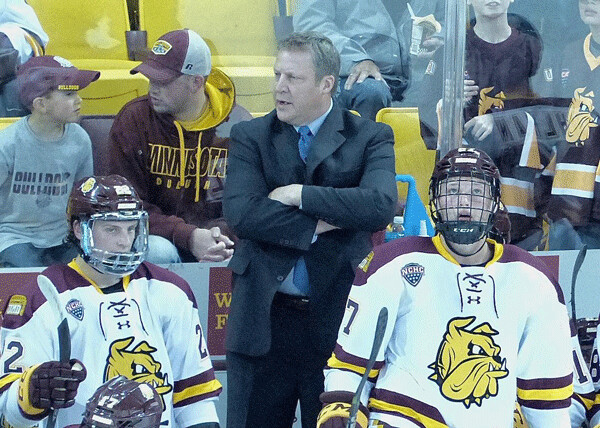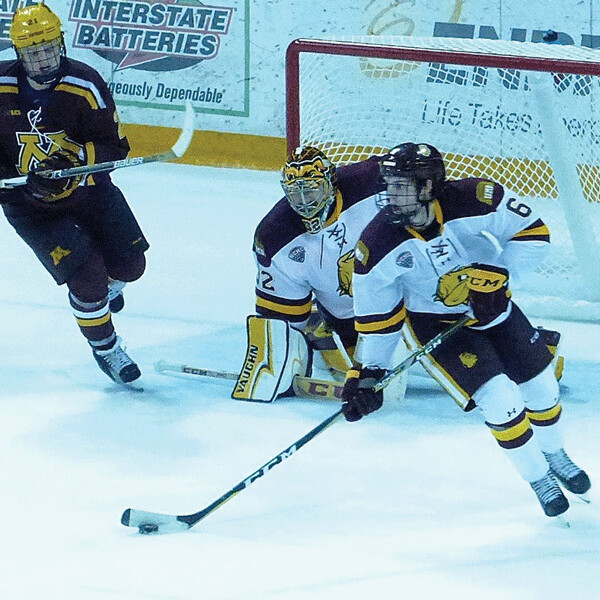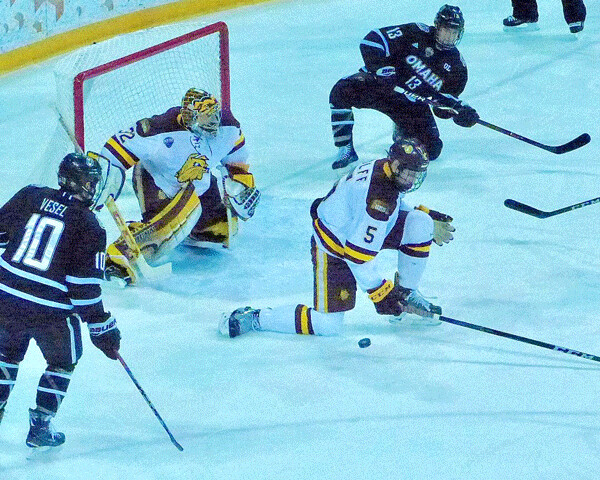News & Articles
Browse all content by date.




Pick a hockey game. Any game. It can be NHL, or college, or even high school, but you aren’t allowed to watch any UMD game just yet.
In any of the selected games, Team A gains control of the puck in its own end, and a defensman goes behind the net and takes maybe one stride before chipping the puck up the side boards. Low, if nobody is at the opposing point, or up high off the glass if there is a point man there. It has become hockey’s version of football’s punt, based on the near-panic fear of turning the puck over. Instead, get it out of the zone with a ricochet off the side boards or glass.
Now switch on a video of UMD’s men’s hockey team in the same situation: More often than not, a defenseman gains control, and takes a look, using whatever time is available to find an open teammate and then sends him a hard, crisp pass, usually right on the tape. That springs a breakout and potentially an offensive rush.
The difference is startling. Sure, other teams might take a look and make a play once in a while, but watch the Bulldogs in this week’s Frozen Four and you will see their poised, patient defensemen taking their time and making a play, rather than merely flingling the puck off the side boards or glass to clear the zone.
“I’m not a big guy for ‘Hope’ plays,” said UMD coach Scott Sandelin. “There’s no shot-clock in hockey, but my feeling is if you possess the puck for even as little as 10 or 15 seconds, that means it’s 10 or 15 seconds the other team doesn’t have it. The longer we have the puck, the longer they don’t.”
UMD reached last year’s Frozen Four with a potent offense and a veteran defense in front of freshman goaltender Hunter Miska. Analyzing that team, it was obvious how and why they got to the championship game before falling to Denver in a tough defensive battle. The success of that veteran outfit — including defensemen Neal Pionk of the Rangers, Carson Soucy just called up by the Wild, and forwards Alex Iafallo with the Los Angeles Kings and Dominic Toninato with Colorado, one year later — make it obvious why last year’s team reached the Frozen Four, but also makes it more surprising that this year’s team has returned to this week’s Frozen Four.
The fact that five freshmen and a sophomore can play with patient, puck-control style so effectively and consistently is a tribute to Sandelin and his staff. They decided early to back off and to let the young players play and tolerate the mistakes inevitable while gaining game experience.
“We made some mistakes, but you’re always going to have that,” said Sandelin. “I think our D has been pretty good all year. They’ve stepped in and played some really good hockey. For all of them to play as well as they have all season is a big reason we’ve had the success we’ve had.
“Back in our end, they don’t panic,” Sandelin added. “They’re patient, and they’re always looking to make a play — sometimes to our own demise. Sometimes you just have to get the puck out across the blue line, and our guys think that if they can’t make a tape-to-tape pass, it’s not a good play. It’s all in the recognition. Under pressure, sometimes what you want to do isn’t the best play.
“But look at our guys on D,” Sandelin said. “We’ve played eight freshmen a lot of games, and they’ve been fine. You can get away with some mistakes by a couple of young forwards, but they can be more costly by young defensemen.”
Sandelin paired hard-hitting 6-foot-4 sophomore Nick Wolff with Scott Perunovich, the mercurial freshman puck-rusher whose defensive play has improved steadily while his offense remains the team’s prized possession. Going into the Frozen Four, the elusive Perunovich is UMD’s leading scorer with 36 points, on 11 goals and 15 assists.
“If we give Perunovich some parameters, he could back off, but he wouldn.t be nearly as effective,” said Sandelin. “He’s responsible and wants to help out on defense, to the point where sometimes I have to get on him to take off more and join the rush.
“Matt Anderson has great skating ability; Mikey Anderson is steady; Dylan Samberg is a big, physical presence; and Louie Roehl has improved all season. We put Mikey and Dylan together and let them try things, just so we can see what works. It takes some time to see where everybody fits.”
Mikey Anderson and Matt Anderson are unrelated. Mikey is the freshman brother of sophomore winger Joey Anderson. “When we were little kids on the outdoor rinks in Roseville, we were always scrapping,” said Mikey. “If I’m a wing, he would be hitting me, and if he was a wing, I’d be hitting him. Either way, mom and dad weren’t happy at the end of the day.”
And now that they’re rejoined, on a college team coming close to home to play at Xcel Center in the Frozen Four, the whole family is happy.
The recruiting skills of head coach Sandelin and top assistants Brett Larson and Jason Herter have been impressive, and Larson, for one, was not willing to write this season off to rebuilding even while trying to sort out new scorers, a new goaltender, and five freshman defensemen.
“Just wait unti you see these freshmen,” said Larson, a former Duluth Denfeld and UMD defenseman who returned to the UMD staff after venturing off to gain experience as a USHL coach and as assistant to old recruiting partner Steve Rohlik at Ohio State. In his time at Ohio State, Larson figures he recruited “about 80 percent of this year’s Ohio State team.”
Meanwhile, back home, the rookies have delivered for the Bulldogs. And sophomore Hunter Shepard, former Grand Rapids star who competed and narrowly lost out to Miska in goal last season, went through the same early-season competition at the start of this season, but won it this time. He has come on through a superb second half to again prove the value of former UMD goaltender and now goalie coach Brant Nicklin.
Sandelin points out that in most games, UMD played eight freshmen. That includes wings Nick Swaney from Lakeville, Kobe Roth from Warroad, and center Justin Richards, who is listed from Columbus, Ohio, because that’s where his dad, former Wild coach and Gopher defenseman Todd Richards, coaches these days. Still, without question, the most astounding thing about this edition of the Bulldogs is the defense. And that goes for the coaching staff, which is both unique and reponsible for the intriguing development of the freshmen on D.
On nearly every college coaching staff, the head coach picks assistants for a defensive specialist and a forward specialist, but not UMD. While Larson played at UMD, Sandelin and Herter were elite defensemen at North Dakota who went on and played some pro hockey. When Sandelin got the UMD job, he added Larson and, for a while, OSU coach Rohlik. Former North Dakota sniper Lee Davidson, and former UMD and NHL star Derek Plante all had their turns as assistants. Larson returned from Columbus to be closer to his young family, just as Plante left, so the UMD staff wound up with three defensemen.
“We all see the game a lilttle differently,” said Larson. “And we all work with the defensemen at different times and offer suggestions. It’s not like most teams, where one defensive coach is the only voice the defensemen hear; with us the guys get a slightly different explanation, delivering the same message. So maybe something from one of us clicks.”
Three voices, but singing in harmony. Larson also has a simple philosophy for the sharp-passing breakouts rather than the simpler off-the-wall escapes.
“We want to possess the puck if we can,” Larson said. “We want getting rid of the puck to be our last option, even though at times you have to do it, like late in a close game when you have to play zone-to-zone hockey.”
The trend in hockey to clear the zone in near-panic mode is a lot like dump and chase in the offensive end, which requires giving up the puck in hopes of maybe getting it back again. As Sandelin said, he and his assistants are not big on “Hope” plays, and his young defensemen have bought into the concept. This week is the final exam, where they put it on display as the lone NCHC representative facing the best from the Big Ten.
| Tweet |


